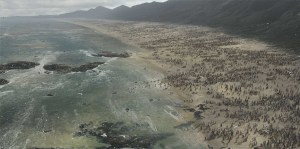 Director Ridley Scott recently tapped London-based VFX house MPC to handle over 500 visual effects shots for Exodus: Gods and Kings, a retelling of the biblical story of Moses. Led by VFX supervisor Jessica Norman and CG supervisor Max Wood, MPC‘s work included huge crowds, massive environments and complex FX work across 10 different scenes.
Director Ridley Scott recently tapped London-based VFX house MPC to handle over 500 visual effects shots for Exodus: Gods and Kings, a retelling of the biblical story of Moses. Led by VFX supervisor Jessica Norman and CG supervisor Max Wood, MPC‘s work included huge crowds, massive environments and complex FX work across 10 different scenes.
For the battle scene early in the movie, MPC extended the practical set, adding a mountain environment to surround the camp as well as extending the crowd digitally. The crowd work included chariots, cavalry and foot soldiers fighting and colliding. The mountain extension was based on photography from Wadi Rum, a valley in Jordan.
MPC worked with motion capture specialists Audiomotion Studios for the challenge of capturing horses and chariots. Like everything on the movie, this was an epic shoot in terms of scale and complexity. Capturing eight horses often paired for the chariot shots with multiple stunt performers on each chariot meant capturing 400 markers moving at considerable speed. With only a few inches between the horses it was a challenge to reconstruct the data. The capture volume covered a total area of 4,300 sq. feet. The blocking of the scene and all of the digital crowd work was completed at MPC’s London studio with all other work carried out in the Montreal office, including cloth and lighting of the crowds, led by Montreal based VFX supervisor Arundi Asregado.
MPC built three armies: Hittites, Egyptians and Hebrews. These armies were used a number of times throughout the movie. MPC also supplied the other vendors with these assets and supplemented their environments with digital crowds. As well as armies, the builds included Egyptian civilians, livestock, hero horses and digi-doubles of Moses and Ramses. All builds were based on photography and scans of the actors and extras.
During one sequence, the Hebrew crowd, followed by an Egyptian army, crosses a mountain and chooses a narrow and treacherous road to reach the Red Sea. The scene was shot across three different locations. MPC’s environment team created the mountain and made the road narrower. The mountain walls needed to be extended up, down and into the distance. Wider aerial shots were shot at Sierra Nevada. Stunt performances were intercut with digital crowds and doubles as the Egyptian army advances. For the falling characters, horses and chariots, MPCs crowd tool ALICE was used together with PAPI, MPCs rigid body solver. Animation added detailing on top of the dynamic solve. The mountain build was based on photogrammetry from aerial photography of Cofete mountain. KALI, MPCs proprietary destruction tool, was used to crack and collapse the mountain with ALICE agents and FX and live-action dust elements were added.
The Red sea sequence was shot across four different beaches on Fuerteventura. The scene includes a combination of live-action plates with environment and crowd extensions as well as full CG shots.
The draining of the Red Sea in front of the Hebrews’ eyes was done by combing FX-generated surfaces with many live-action elements shot at river locations in Vancouver and London. For some camera angles, SFX created the disturbed surface using jet-skis that were placed out of camera. MPC added 300,000 CG crowd birds giving the sequence an extra feel of frenzy and drama. Ridley Scott wanted operatic and performing skies throughout the scene, ramping up the drama to the point where the wave approaches on the horizon. The environment, compositing and roto teams worked together to create and combine the CG dark skies with particularly sunny backlit live-action actors and extras.
The look and movement of the wave was defined early on by Scott’s sketches and concept art from the production team. To create and art direct the 160 foot tall wave, the company started off with an animation rig that defined the shape, position and speed of the wave. MPC worked with Scanline FX and their Flowline water simulation software to create churning water travelling in front of the wave and breaking water on the wave’s lip. The wave finally hits Ramses and Moses and they are pulled under the water. Stunt elements were shot for both characters that were placed into MPC’s digital environment and the crashing wave. Live action elements were shot on the underwater stage at Pinewood and combined with digital crowd elements for the underwater shots.





